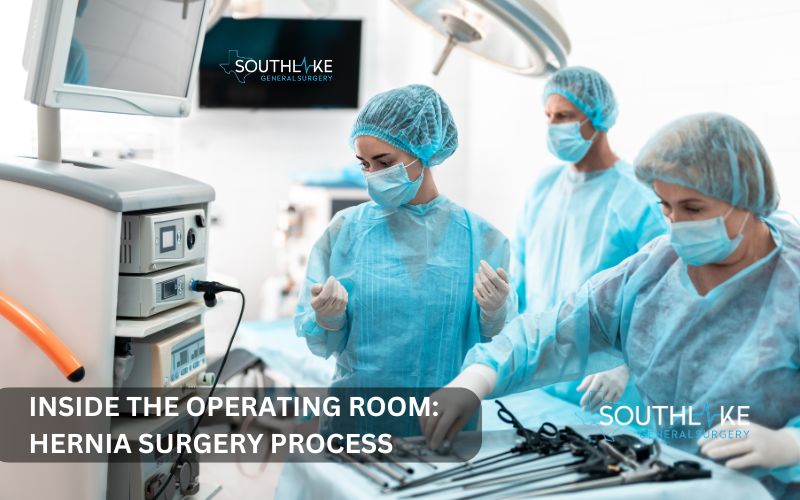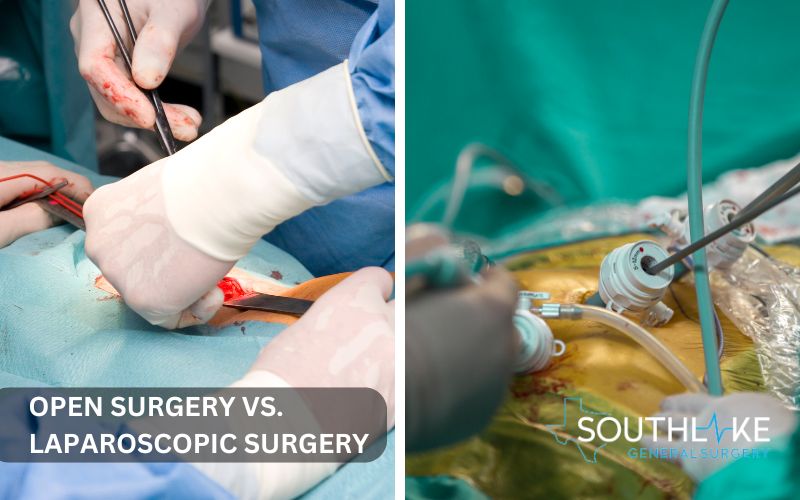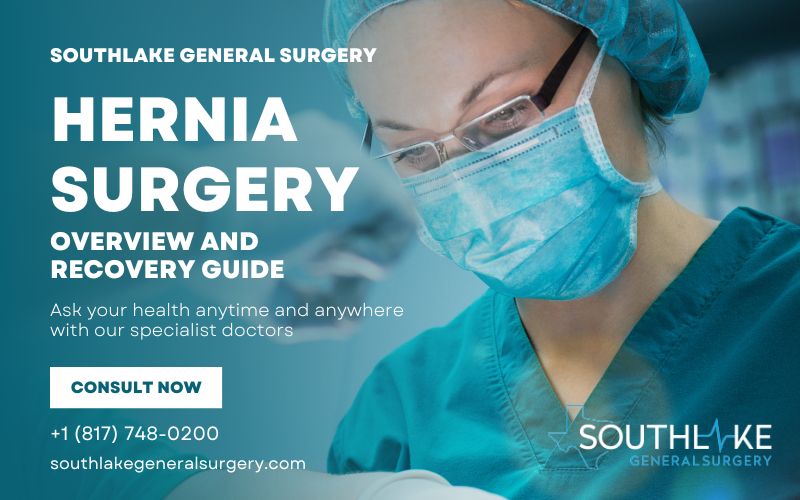Hernia surgery is a usual procedure. The procedure is performed to address a hernia. There are two main approaches to hernia repair: open surgery and laparoscopic surgery. Every approach presents distinct benefits and drawbacks, influencing aspects like recovery time, pain intensity, and cosmetic results.
Key Highlights
- A hernia occurs when a portion of the body protrudes through a weak area in the muscle or tissue wall.
- Most hernias develop in the groin or belly button region.
- They may not always require immediate attention, but if left untreated, they can worsen. Many patients require surgery to fix them.
- Hernia surgery is common and generally safe. Repositions the herniated tissue to its proper location while strengthening the injured region.
- There are two primary approaches to hernia repair: open surgery and laparoscopic surgery. Each type has advantages and disadvantages, including recovery time, pain levels, and appearance.
Defining Hernia: Types and Symptoms

A hernia occurs when an internal organ or tissue protrudes through a weak area in the tissue wall. You might notice a bulge forming just beneath your skin. Hernias come in various types. Different types impact various areas of the body and come with their unique symptoms.
- An inguinal hernia includes a distinct classification of hernias. The inguinal canal is a passage located in the groin area where this occurs. This canal is responsible for carrying the spermatic cord through the abdominal wall in men. For women, it supports the round ligament. An inguinal hernia typically appears as a noticeable bulge in the groin area. This bulge may become more noticeable when you cough or exert yourself physically.
- It is important to recognize additional types of hernias that exist. Femoral hernias can be found in the upper thigh, umbilical hernias are located near the belly button, and incisional hernias appear at surgical sites.
- Regardless of the type, hernias typically present as a visible lump or bulge. Such conditions can result in discomfort or pain, particularly when engaging in activities like lifting, coughing, or straining.
The Importance of Timely Surgical Intervention
While not every hernia needs immediate surgery, many will eventually require it at some stage. Hernias typically do not heal by themselves. They may become more challenging over time. If you overlook a hernia, the weak area may enlarge over time.
It’s important to be aware that this can result in some serious complications, like bowel obstruction or strangulation, which can pose significant risks.
- Performing surgery is essential in minimizing the risk of complications.
- It provides support to the affected area and prevents further bowel movement.
- Surgical procedures not only eliminate life-threatening issues, but also provide permanent relief from pain and discomfort.
- This helps you to return to your regular activities and improves your overall quality of life.
Seeking a timely evaluation from a healthcare provider is essential for an accurate diagnosis. Discuss the most effective treatment options with them, particularly if you are experiencing any symptoms.
Be vigilant for signs such as a prominent bulge or persistent pain and discomfort in the abdominal or groin region.
Preparing for Your Hernia Surgery
Beginning the journey to surgery often raises a lot of questions and can bring about feelings of concern. It’s important to have a complete checkup before scheduling your hernia surgery. This step ensures that you are fully prepared, both physically and mentally, for the operation.
The assessment looks at your complete medical history. It’s important to talk about any health issues you’re currently experiencing or any medications you’re taking.
Next, your doctor will perform a physical exam. This exam allows them to assess the size and position of your hernia. It will help you find the best approach for your surgery.
Consultation with Dr. Valeria Simone: What to Expect
In your upcoming meeting, Dr. Simone, an expert in hernia care, will discuss your medical history and address any concerns you may have. Our care team will review your previous medical records and conduct a thorough physical examination. This exam will help determine the size and location of the hernia, while also looking at your overall health.
Discuss anything you want in the meeting. Dr. Simone is available to answer any questions you may have regarding the operation. This covers inquiries regarding the risks, benefits, and expected duration of recovery. She wants to help you understand what is going on. She also gives advice that is personal to you.
Dr. Simone and her care team are here to ensure you have a clear understanding of the surgery plan. They will also discuss how to look after yourself following the surgery. You’ll discover what to anticipate during your recovery journey.
Pre-Surgery Checklist: Dietary, Physical, and Mental Preparation

Getting ready for surgery involves more than just understanding what will happen. It’s important to take care of both your body and mind. Consider these important steps to remember:
- Stay prepared physically by following your diet guidelines. It’s recommended to refrain from eating or drinking after midnight prior to your surgery.
- In the days preceding surgery, do light exercises, such as walking. Doing so helps in the body’s healing process.
- Just talking to a trusted friend or family member about your concerns can help you relax and get ready.
The Surgical Journey: From Operation Room to Recovery

Stepping into the surgery room can be quite a lot to take in. Understanding the surgery process can really help to calm your anxieties.
You’ll either get general anesthesia, which will help you to sleep, or local anesthesia, which will numb the specific area being treated. The kind of anesthesia you’ll receive is based on the specific hernia repair procedure you’re having.
After the anesthesia takes effect, the team thoughtfully carries out the procedure. They make sure you feel secure and at ease the whole time.
Once your surgery is complete, you’ll be moved to a recovery area to rest and begin your healing process. The staff here will keep an eye on you and are ready to provide pain relief medication if you need it.
Step-by-Step Guide to Hernia Surgery Procedure

Hernia repair surgery is commonly referred to as herniorrhaphy. This surgery is designed to repair a hernia. There are two primary approaches to hernia repair surgery: open surgery and laparoscopic surgery.
- Open surgery is the standard procedure. A single large incision is necessary for the closure of the hernia. This provides the surgeon with a precise perspective to execute the necessary repairs. Surgical mesh is commonly used to provide support during the repair process.
- Laparoscopic surgery is a technique that is less invasive. It utilizes multiple small incisions rather than a single large cut. A laparoscope is a thin tube equipped with a camera and light that assists the surgeon in viewing and fixing the hernia.
Your surgeon will determine the most suitable strategy for conducting the surgery. They will consider several factors. This includes the size and location of the hernia, your overall health, and your medical history.
Post-Surgery Care: First 24 Hours After Hernia Repair
After your hernia repair, you’ll be moved to the recovery area where our dedicated healthcare team will keep a close eye on your vital signs and make sure you’re comfortable.
You’ll receive pain medication to help ease any discomfort as the anesthesia starts to wear off, which will help reduce pain and boost your alertness.
It’s an ideal plan to begin with gentle movements on your first day and then gradually increase your activity as you start to feel more comfortable.
Adding deep breathing exercises to your routine can really enhance your lung health and help lower the chances of complications.
The length of your stay will depend on the type of surgery you have; you might be able to go home the same day or need to stay overnight.
It typically takes a couple of weeks to recover before you can resume your daily activities. On the other hand, patients who undergo laparoscopic hernia repair surgery usually need to wait about 1-2 weeks before they can get back to their regular routine.
Navigating the Recovery Process
It will take time for you to recover after hernia surgery. If you are familiar with the steps, you will have a better understanding of what to expect.
- In the first week, you may notice a slight reduction in pain. You can begin to resume your regular routine with this.
- During this period, you must rest.
- Take your time before returning to your usual activities. It is important to adhere to the guidance provided by your surgeon regarding your activities.
- Gradually increase your level of physical activity. This promotes healing and minimizes the possibility of complications, facilitating a smoother recovery process.
Short-term Recovery: Week 1-2 Post-Surgery Insights
During the first week or two following your hernia surgery, you’ll begin to observe the healing process of your body. It’s an ideal way to gradually begin incorporating some light activities into your routine!
It’s completely normal to experience a bit of discomfort, but don’t worry—things should improve as time passes. Your doctor can prescribe pain medication to assist with any discomfort you may be experiencing.
- Begin with gentle activities such as taking short walks.
- Gradually increase the duration and intensity of your walks as you start to feel better.
- In the first few weeks, you should not exert yourself by lifting heavy objects or doing strenuous workouts. Both the prevention of problems and the promotion of healthy recovery will be facilitated by this.
Listen carefully to the indications your body is giving you. If you feel it is important to take a break, please prioritize that for your well-being! If you experience any unusual pain or see swelling, it’s worthwhile to look for any redness around the incision.
Do not hesitate to contact your surgeon for immediate help if you have a fever.
Long-term Healing: Lifestyle Adjustments for a Full Recovery

As you recover from surgery, it’s vital to consider making certain changes in your life. This can assist you in feeling better and lower the probability of problems coming back.
To achieve this, maintain a healthy weight by enjoying nutritious foods and staying active with regular exercise.
- Follow the instructions from your physician and gradually increase the intensity of your workouts.
- It may take a few weeks before you can resume your usual activity level. This depends on your job and how active you are.
- Exercise patience. It is important to take your time and avoid exerting yourself excessively during this period.
It will improve your physical strength and contribute positively to your overall well-being. This may decrease your chance of recurrent hernias and improve your overall health over time.
Conclusion
In conclusion, hernia surgery is a widely used option. It can be beneficial in reducing the pain and discomfort associated with hernias.
When patients learn about the various types of hernias, the different surgical options available, and what to anticipate during recovery, they can feel more ready and informed about their surgery.
Make sure to adhere to your doctor’s instructions carefully as you recover. This will assist you in healing properly. With proper care, many patients can resume their usual activities within a few weeks following surgery.
Never hesitate to contact your healthcare professional if you require further information or have any inquiries. Feel free to reach out to them for assistance and support. Continue to look after yourself as you heal. Take care of your health and well-being!
Make an Appointment
To make an appointment with Dr. Valeria Simone MD at Southlake General Surgery in Texas, call +1 (817) 748-0200. Dr. Simone excels in performing hernia surgeries. She performs both laparoscopic and open surgeries to address various types of hernias.
Feel free to reach out to our healthcare expert for assistance in finding the best surgery tailored to your needs and medical history. Start your path to improved recovery by reaching out to us!
We offer a thorough check-up along with a personalized treatment plan designed specifically for your needs.
Frequently Asked Questions
How much time will I have to spend in the hospital following hernia repair surgery?
Your hospital stay will vary based on the specific type of hernia surgery you undergo. If you receive minimally invasive hernia surgery, such as laparoscopic hernia repair, there’s a good chance you can head home on the same day! If you require open surgery for more complex hernias, it’s possible that you’ll need to spend one or two nights in the hospital.
Can a hernia operation affect my daily activities and for how long?
Yes, hernia surgery can have an impact on your daily life for a while. The time required for recovery can differ from one individual to another. Usually, you can begin engaging in light activities after just a few days. However, it’s recommended to avoid heavy activities for a few weeks. This period allows your abdominal muscles to recover properly.
Will my stomach be flat after hernia surgery?
Hernia repair focuses on fixing a weak area in the abdominal wall, aiming to restore its strength and function effectively. This surgery can help make a bulge look better. However, it will not always result in a flat stomach. The appearance of your body following surgery may vary from person to person.
What is the expected rate of weight loss following hernia surgery?
No substantial weight loss will occur after hernia surgery. In most cases, weight changes are subtle. Possible causes of these alterations include post-operative swelling and changes in dietary habits. It is critical to maintain a healthy weight and regular exercise routine once you feel better.
Medically Reviewed By: Dr. Valeria Simone MD
Board-certified General Surgeon at Southlake General Surgery, Texas, USA.
Follow us on Facebook and YouTube.
References:
- Inguinal hernia repair. medlineplus.gov/ency/article/007406.htm. (https://medlineplus.gov/ency/article/007406.htm)
- —. “Hernias.” Surgical Treatment – NCBI Bookshelf, 2001, www.ncbi.nlm.nih.gov/books/NBK6888.
- Haladu N, Alabi A, Brazzelli M, Imamura M, Ahmed I, Ramsay G, Scott NW. Open versus laparoscopic repair of inguinal hernia: an overview of systematic reviews of randomised controlled trials. Surg Endosc. 2022 Jul;36(7):4685-4700. doi: 10.1007/s00464-022-09161-6. Epub 2022 Mar 14. PMID: 35286471; PMCID: PMC9160137.
- “Open Inguinal Hernia Repair.” StatPearls – NCBI Bookshelf, 12 Sept. 2022, www.ncbi.nlm.nih.gov/books/NBK459309.
- Hope, William W., and Christopher Pfeifer. “Laparoscopic Inguinal Hernia Repair.” StatPearls – NCBI Bookshelf, 3 July 2023, www.ncbi.nlm.nih.gov/books/NBK430826.

